UE4/5C++之SubSystem的了解与创建
Posted 多方通行8
tags:
篇首语:本文由小常识网(cha138.com)小编为大家整理,主要介绍了UE4/5C++之SubSystem的了解与创建相关的知识,希望对你有一定的参考价值。
目录
创建SubSystems中的UGamelnstanceSubsystem类:
创建SubSystems中的UEditorSubsystem类:
SubSystem是什么就不多说了,可以看看大钊的相关文章:
《InsideUE4》GamePlay架构(十一)Subsystems - 知乎 (zhihu.com)
这篇文章很好的讲解了关于SubSystems的相关内容,我也就讲讲应该需要知道的重点和怎么做:
了解生命周期
第一步是了解SubSystems中提供框架中的5个生命周期:
UEngineSubsystem
代表引擎,数量1。Editor或Runtime模式都是全局唯—,从进程启动开始创建,进程退出时销毁。
UEditorSubsystem
代表编辑器,数量为1。顾名思义,只在编辑器下存在且全局唯—,从编辑器启动开始创建,到编辑器退出时销毁。
UGamelnstanceSubsystem
代表—场游戏,数量1。从游戏的启动开始创建,游戏退出时销毁。这里的—场游戏指的是Runtimea或PIE模式的运行的都算,—场游戏里可能会创建多个World【或者叫Level】切换。
UWorldSubsystem
代表—个世界,数量可能>1。其生命周期跟归属的World【或者叫Level】有关
代表本地玩家,数量可能>1。UE支持本地分屏多玩家类型的游戏,但往往最常见的是就只有一个。LocalPlayer虽然往往跟Playercontroller—
ULocalPlayerSubsystem
起访问,但是其生命周期其实是跟UGamelnstance—起的(默认—开始的时候就创建好—定数量的本地玩家),或者更准确的说是跟LocalPlayer的具体数量挂钩(当然你也可以运行时动态调用AddLocalPlayer)。
为什么用他,简单讲解?
不仅仅是因为其中的5个生命周期,更是因为其的可移植性强,并且可以解放你的双手,无需时时刻刻考虑内存问题:类似于在哪里new和在哪里delete的问题。
避免某个如pawn类,gameinstance类过于臃肿。
方便团队合作不同模块,方便不同插件的引用。
更好的封装,避免了数据污染。
甚至可以最为简单粗暴的将里面的内容复制粘贴到其他项目中。
SubSystems创建和使用
那么在了解了生命周期之后,想必如果想要做一个计分系统之类的东西,大家都应该知道要在哪个生命周期制作了把。
这里我就做继承于UGamelnstanceSubsystem的类了。
创建SubSystems中的UGamelnstanceSubsystem类:
正常c++创建搜索:
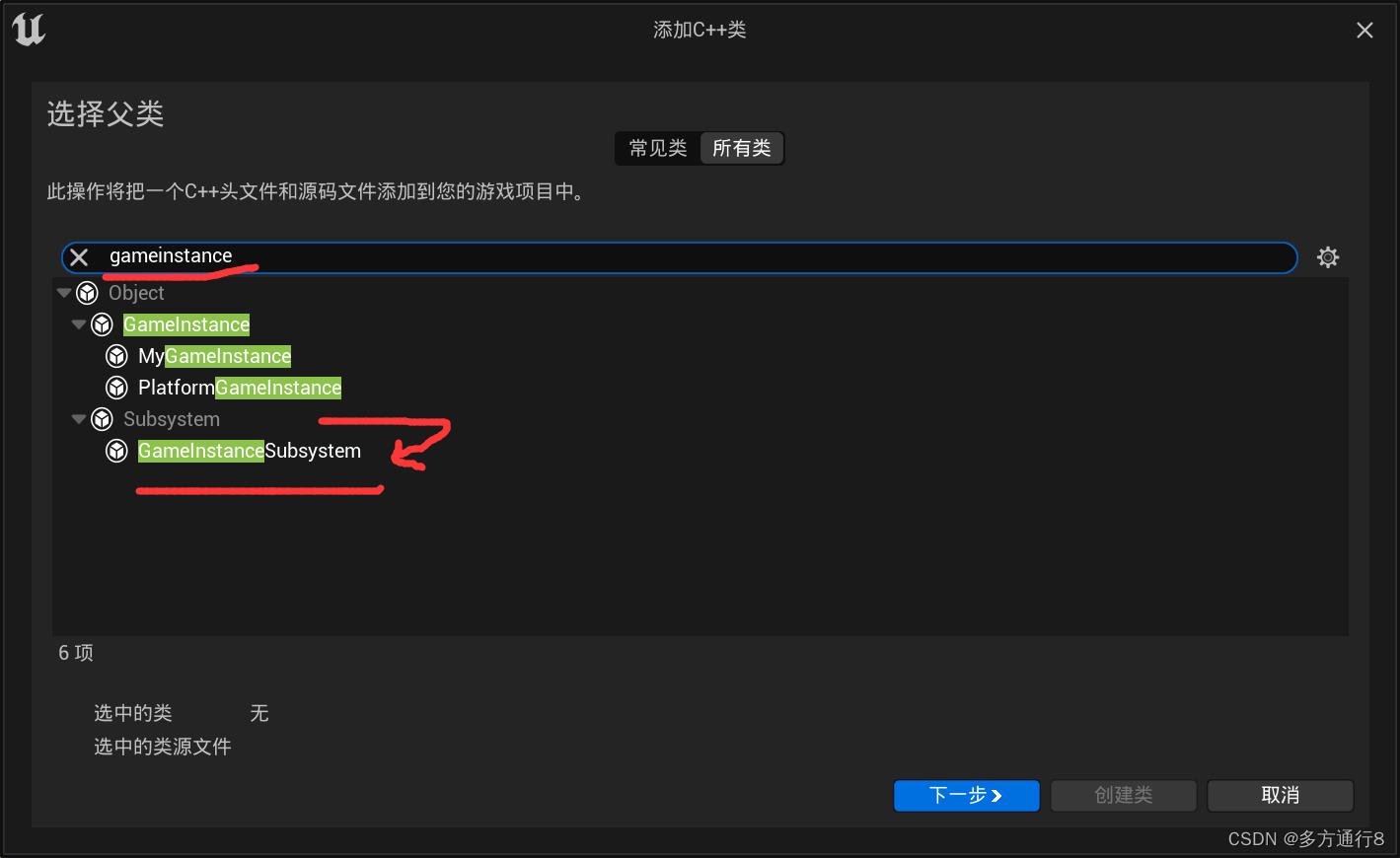
这个命名其实可以取各个不同的系统,因为它的可移植性,所以这个系统模块是很好让其他人进行分工合作的,比如计分系统写一个这个,血量系统写一个这个。
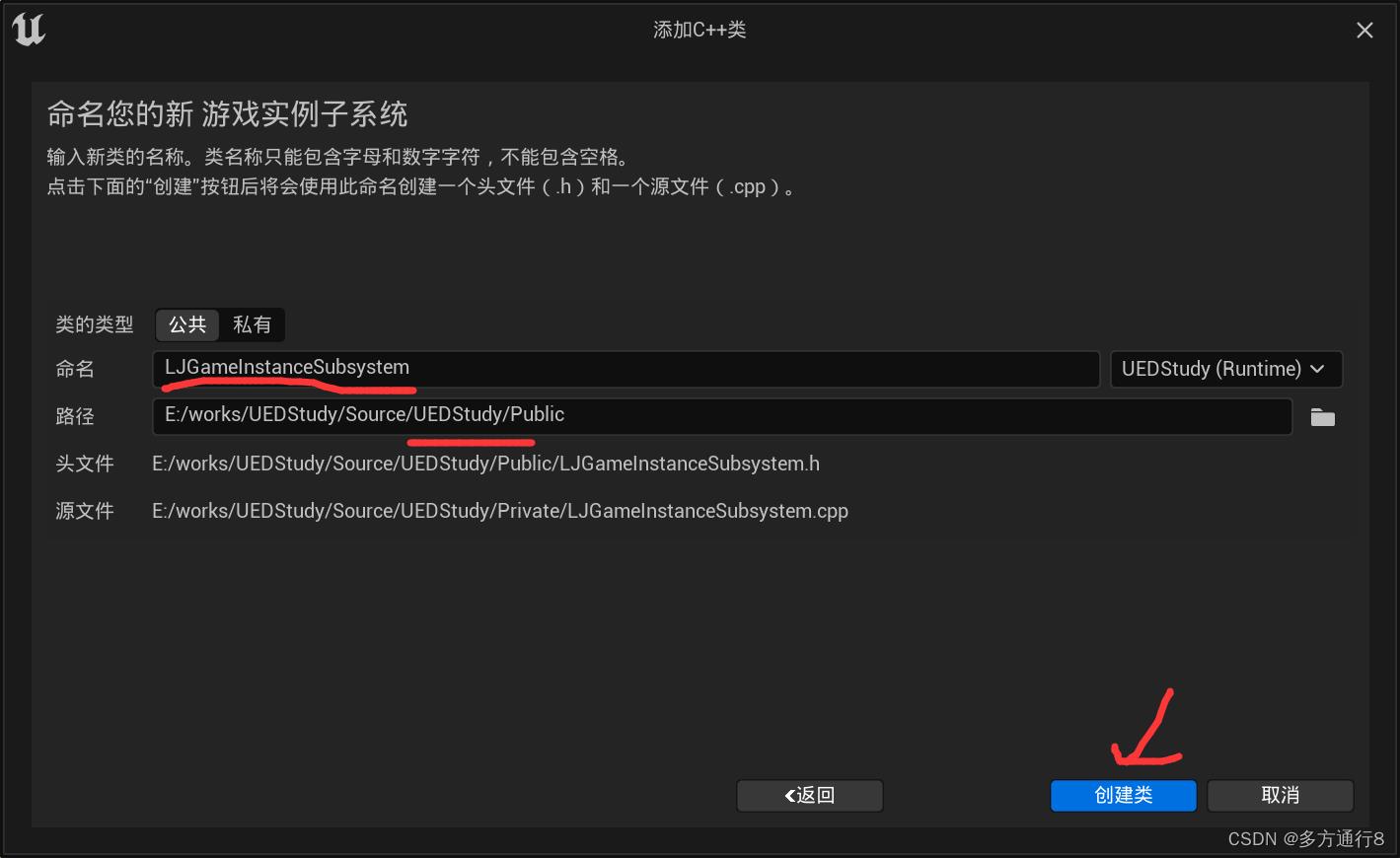
然后我们可以看见这个空空如也的类。

对此我们需要写3个函数。
写基本的3个函数:
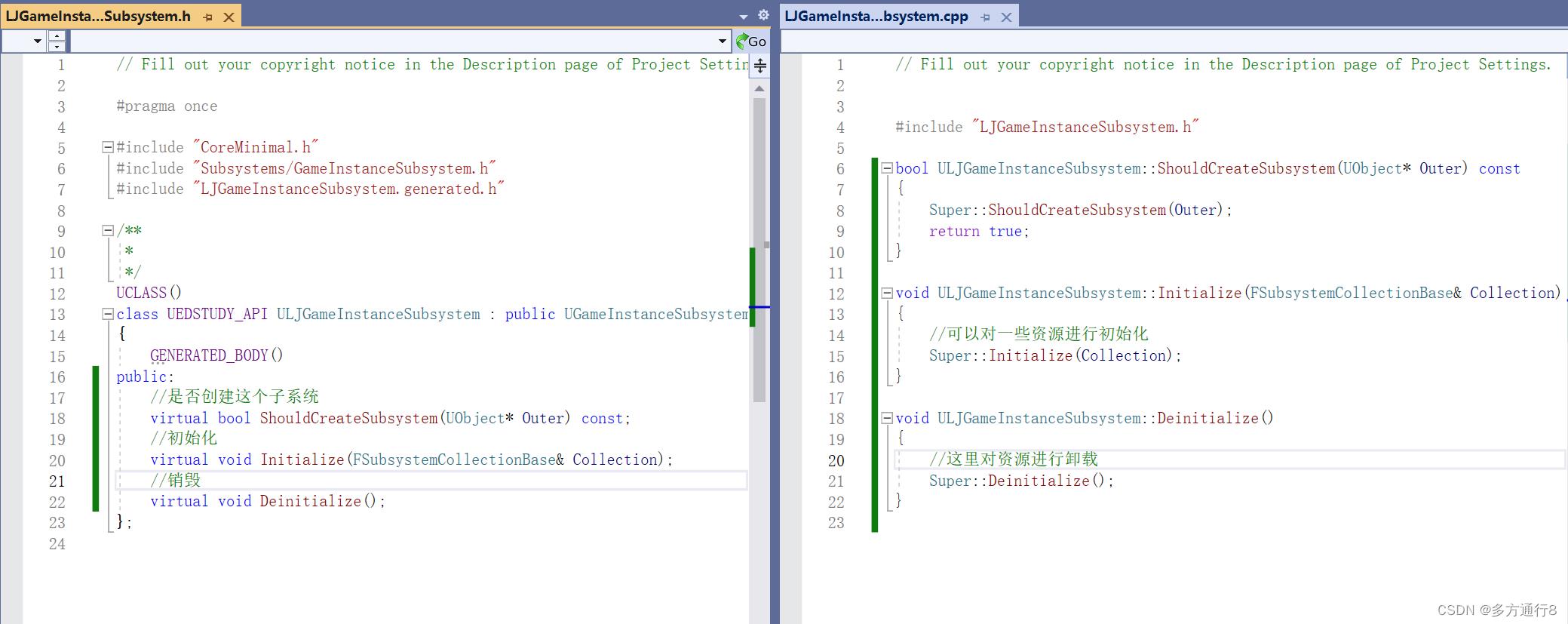
头文件:
// Fill out your copyright notice in the Description page of Project Settings.
#pragma once
#include "CoreMinimal.h"
#include "Subsystems/GameInstanceSubsystem.h"
#include "LJGameInstanceSubsystem.generated.h"
/**
*
*/
UCLASS()
class UEDSTUDY_API ULJGameInstanceSubsystem : public UGameInstanceSubsystem
GENERATED_BODY()
public:
//是否创建这个子系统
virtual bool ShouldCreateSubsystem(UObject* Outer) const;
//初始化
virtual void Initialize(FSubsystemCollectionBase& Collection);
//销毁
virtual void Deinitialize();
;cpp文件:
// Fill out your copyright notice in the Description page of Project Settings.
#include "LJGameInstanceSubsystem.h"
bool ULJGameInstanceSubsystem::ShouldCreateSubsystem(UObject* Outer) const
Super::ShouldCreateSubsystem(Outer);
return true;
void ULJGameInstanceSubsystem::Initialize(FSubsystemCollectionBase& Collection)
//可以对一些资源进行初始化
Super::Initialize(Collection);
void ULJGameInstanceSubsystem::Deinitialize()
//这里对资源进行卸载
Super::Deinitialize();
然后我们在创建一个简单的变量,和一个函数。
在蓝图中的样子:
然后在蓝图中可以看见:
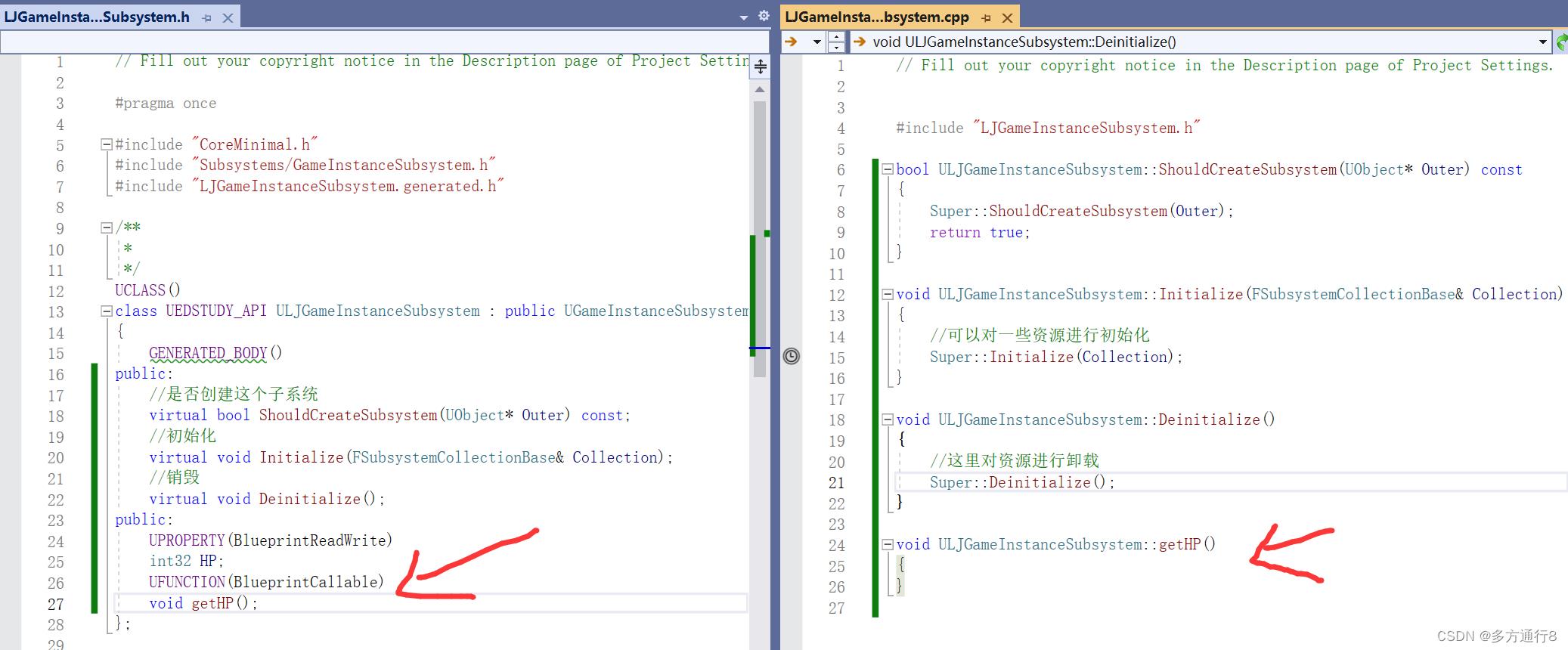
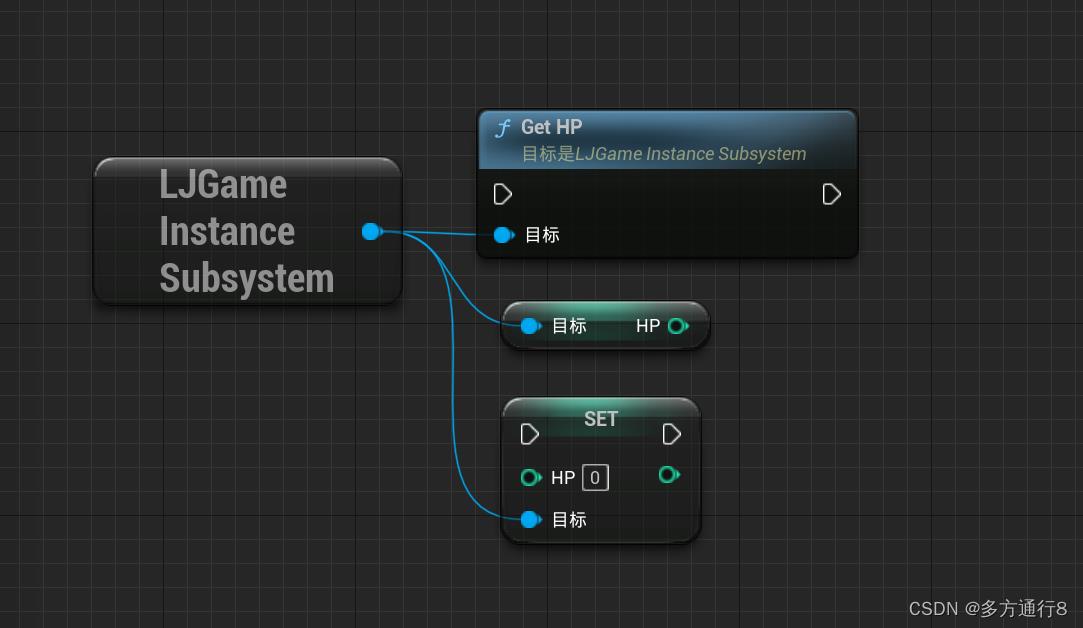
如果想要在蓝图中创建,就需要加一些东西:
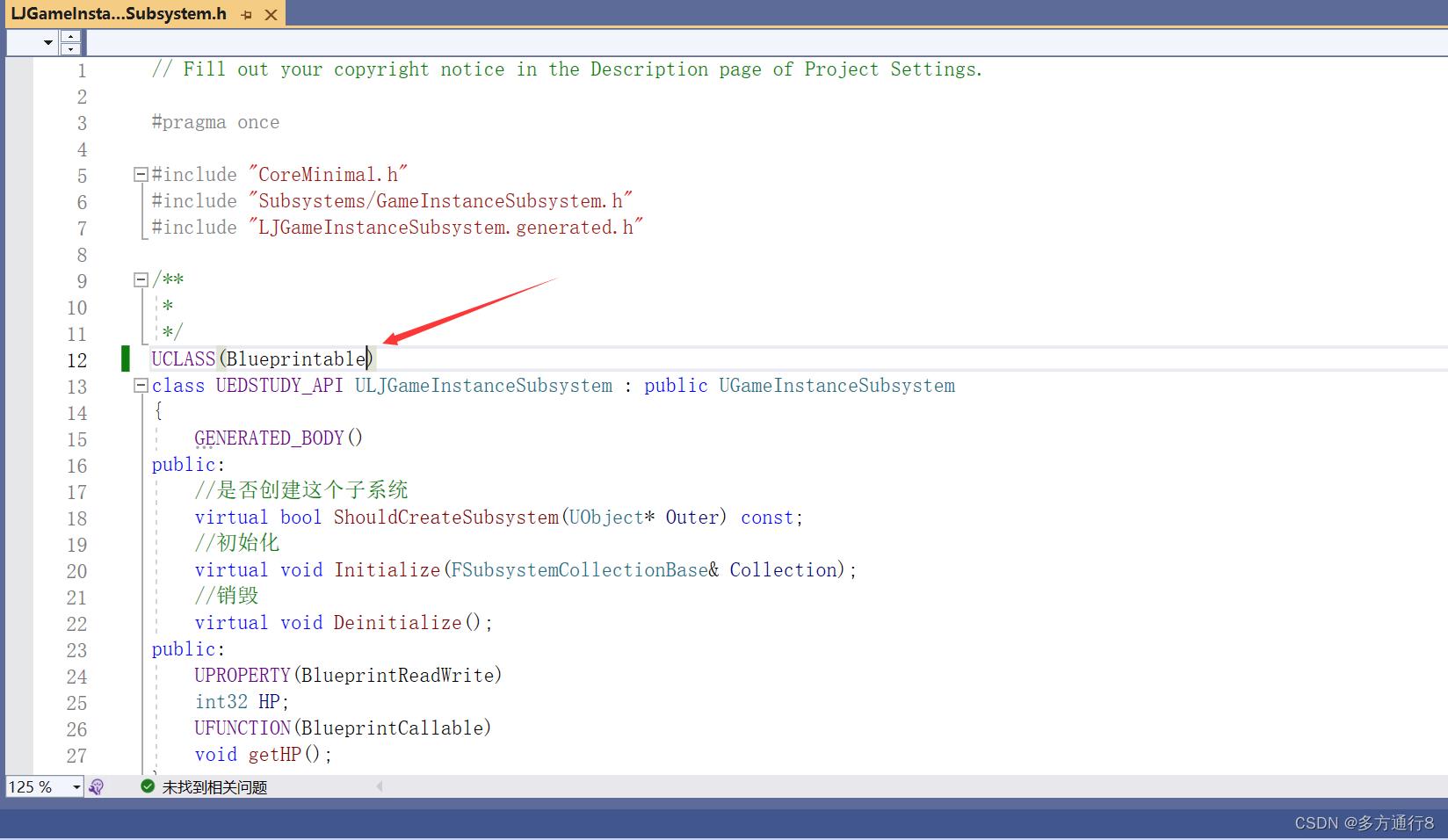
详情可以看这个:
UE4/5关于c++中的actor组件无法创建蓝图类的解决方法_多方通行8的博客-CSDN博客
UE4/5C++之关于UCLASS()的说明符和元数据修饰符_多方通行8的博客-CSDN博客
然后就可以创建了:
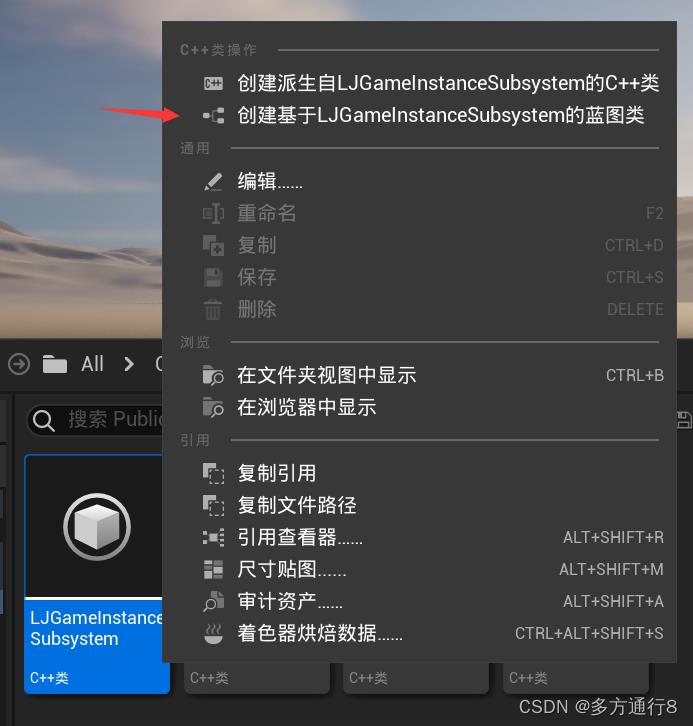
创建SubSystems中的UEditorSubsystem类:
和之前创建UGameInstanceSubsystem一样,对此我就直接在项目中直接创建了:
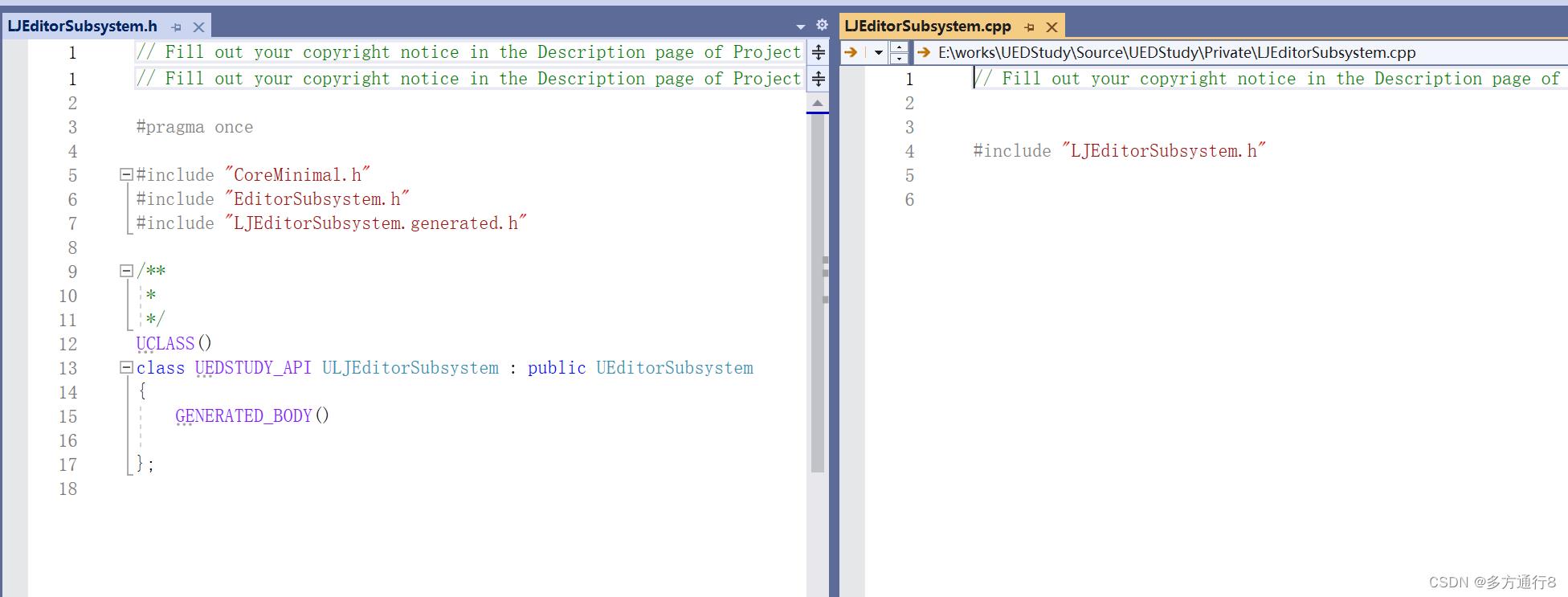
然后这样:
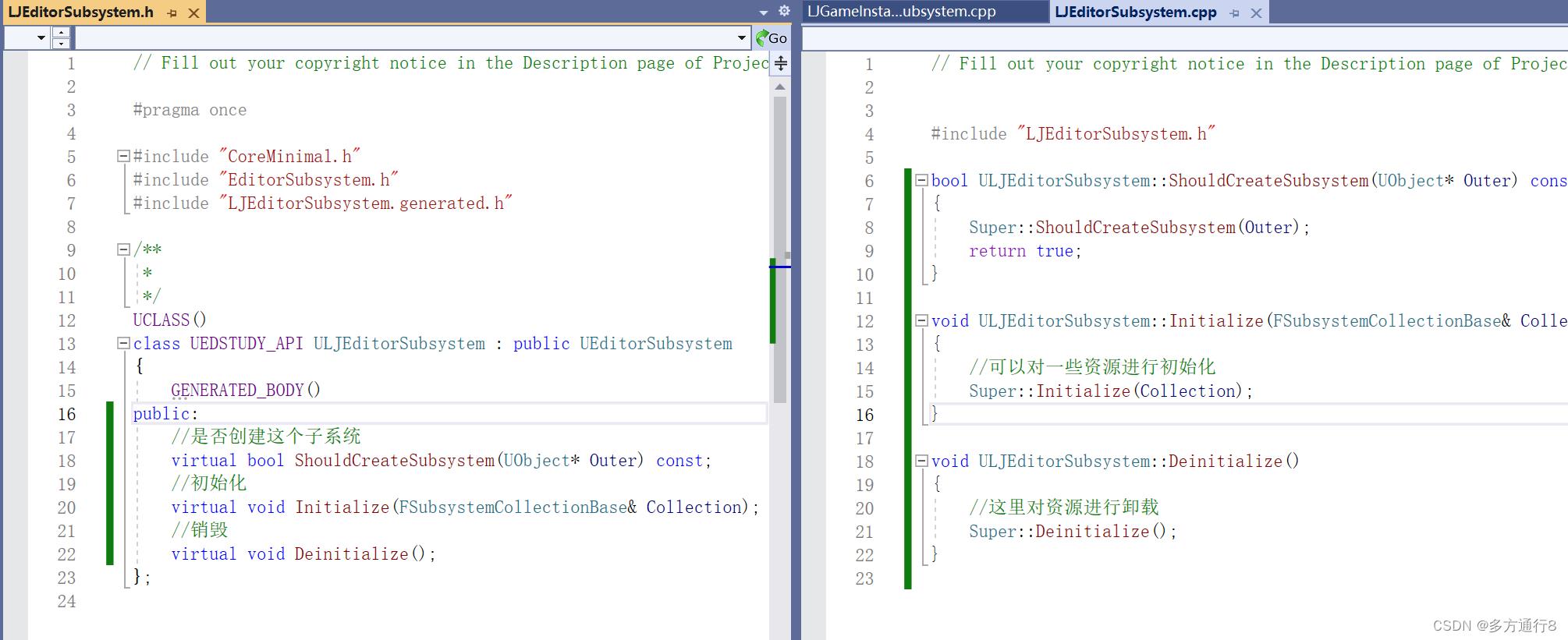
头文件:
// Fill out your copyright notice in the Description page of Project Settings.
#pragma once
#include "CoreMinimal.h"
#include "EditorSubsystem.h"
#include "LJEditorSubsystem.generated.h"
/**
*
*/
UCLASS(Blueprintable)
class UEDSTUDY_API ULJEditorSubsystem : public UEditorSubsystem
GENERATED_BODY()
public:
//是否创建这个子系统
virtual bool ShouldCreateSubsystem(UObject* Outer) const;
//初始化
virtual void Initialize(FSubsystemCollectionBase& Collection);
//销毁
virtual void Deinitialize();
;
cpp文件:
// Fill out your copyright notice in the Description page of Project Settings.
#include "LJEditorSubsystem.h"
bool ULJEditorSubsystem::ShouldCreateSubsystem(UObject* Outer) const
Super::ShouldCreateSubsystem(Outer);
return true;
void ULJEditorSubsystem::Initialize(FSubsystemCollectionBase& Collection)
//可以对一些资源进行初始化
Super::Initialize(Collection);
void ULJEditorSubsystem::Deinitialize()
//这里对资源进行卸载
Super::Deinitialize();
创建这个之后,我们需要注意的是需要在项目的bulid.cs中输入:
"EditorSubsystem"这个模块才能编译成功【而我的UE5可以不输入这个模块就成功了,不知道是什么原因,但我还是写出来,以防止各位可能出现相关的问题】
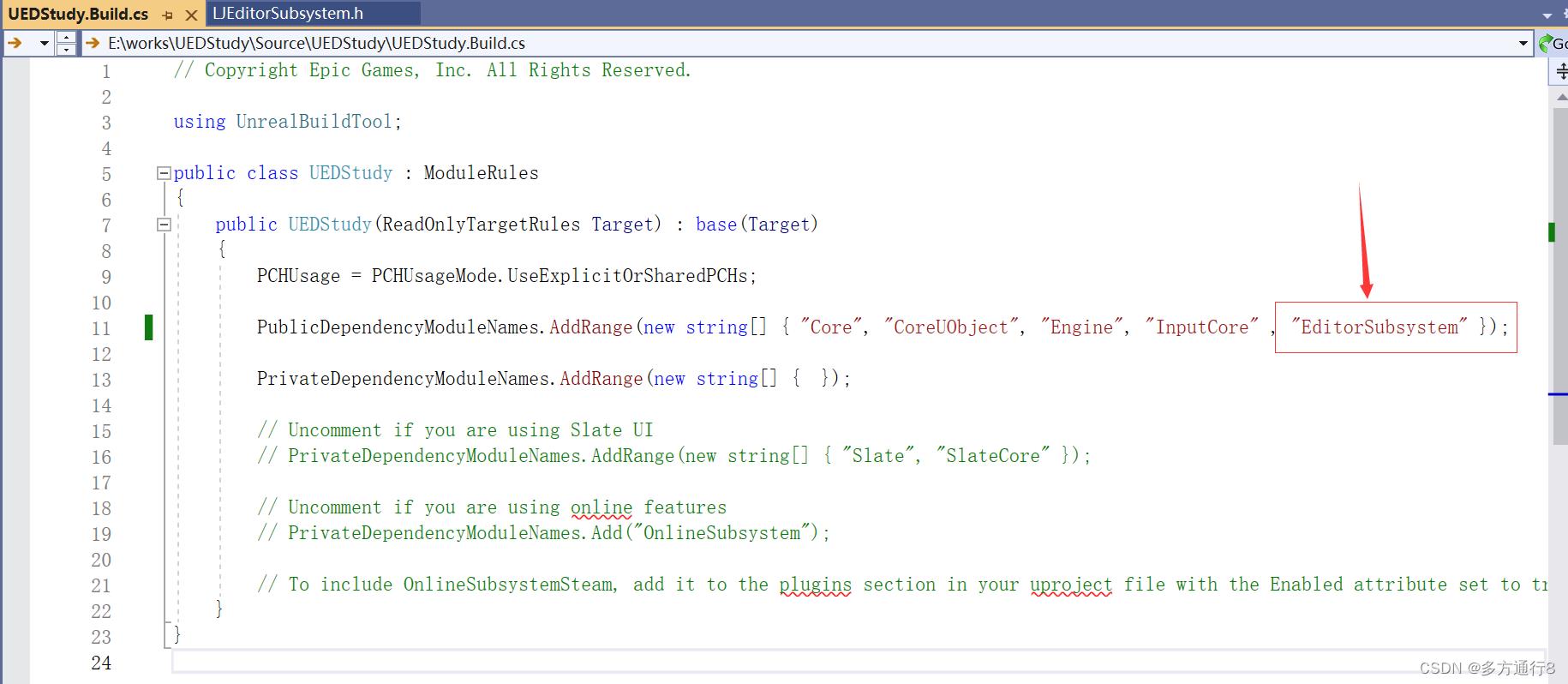
然后在蓝图中的这里看到:
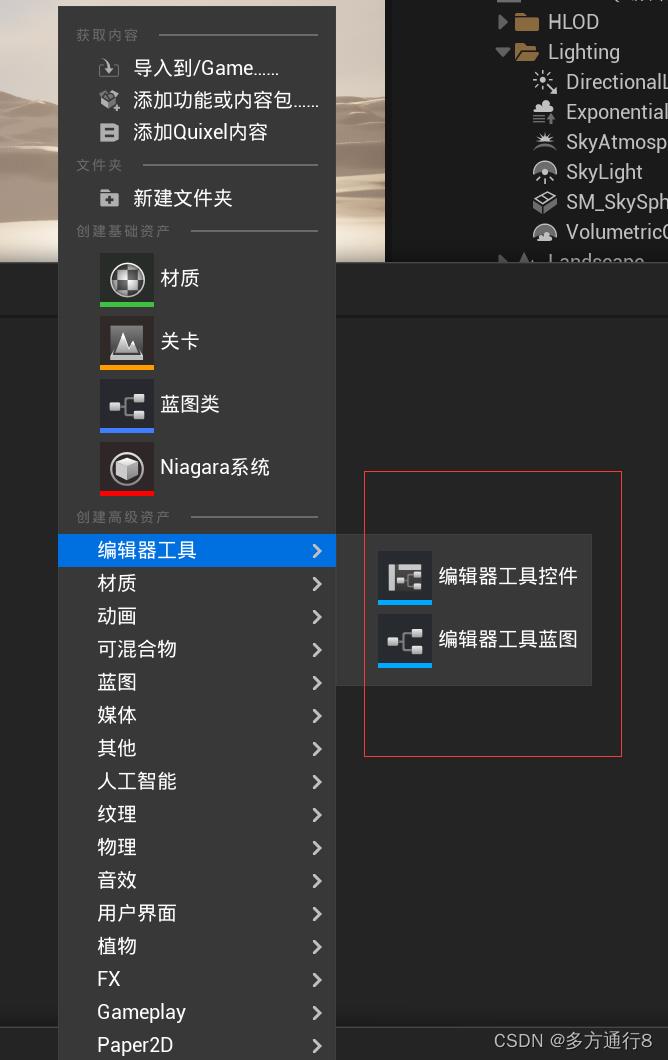
因为都是编辑器的生命周期,所以在其他的蓝图里面只能进行cast to 某个类,而无法直接看到这个,所以我们才能在编辑器工具中看到:
不论是编辑器工具控件或者是编辑器工具蓝图都可以看见:
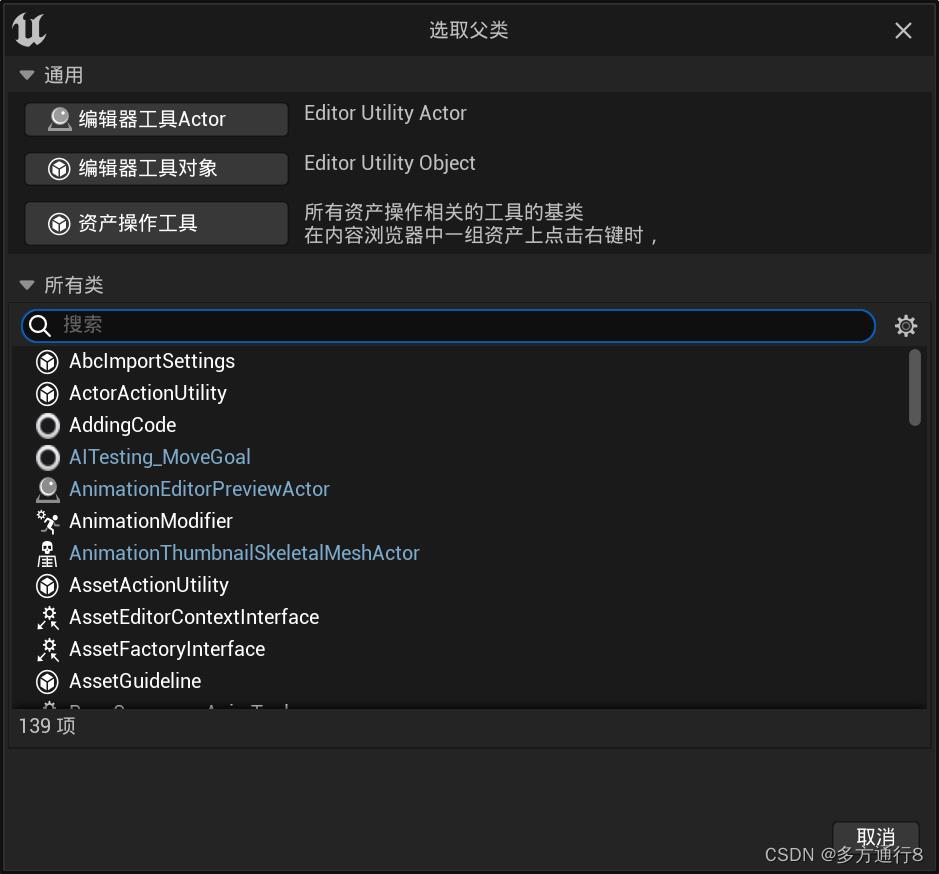


linux输入子系统(input subsystem)之按键输入和LED控制
实验现象:在控制台打印按键值,并且通过按键控制相应的LED亮灭。
1.代码
input_subsys_drv.c
1 #include <linux/module.h> 2 #include <linux/version.h> 3 4 #include <linux/init.h> 5 #include <linux/fs.h> 6 #include <linux/interrupt.h> 7 #include <linux/irq.h> 8 #include <linux/sched.h> 9 #include <linux/pm.h> 10 #include <linux/sysctl.h> 11 #include <linux/proc_fs.h> 12 #include <linux/delay.h> 13 #include <linux/platform_device.h> 14 #include <linux/input.h> 15 #include <linux/irq.h> 16 17 #include <asm/gpio.h> 18 #include <asm/io.h> 19 #include <asm/arch/regs-gpio.h> 20 21 22 struct pin_desc{ 23 int irq; 24 char *name; 25 unsigned int pin; 26 unsigned int key_val; 27 }; 28 29 struct pin_desc pins_desc[4] = { 30 {IRQ_EINT0, "S2", S3C2410_GPF0, KEY_L}, 31 {IRQ_EINT2, "S3", S3C2410_GPF2, KEY_S}, 32 {IRQ_EINT11, "S4", S3C2410_GPG3, KEY_ENTER}, 33 {IRQ_EINT19, "S5", S3C2410_GPG11, KEY_LEFTSHIFT}, 34 }; 35 36 static struct input_dev *input_subsys_dev; 37 static struct pin_desc *irq_pd; 38 static struct timer_list buttons_timer; 39 40 static irqreturn_t buttons_irq(int irq, void *dev_id) 41 { 42 /* [cgw]: 按键IO发生边沿中断时重新设置定时间隔 43 * 用于按键消抖 44 */ 45 irq_pd = (struct pin_desc *)dev_id; 46 buttons_timer.data = irq_pd->pin; 47 mod_timer(&buttons_timer, jiffies+HZ/100); 48 return IRQ_RETVAL(IRQ_HANDLED); 49 } 50 51 static void buttons_timer_function(unsigned long data) 52 { 53 struct pin_desc * pindesc = irq_pd; 54 unsigned int pinval; 55 56 if (!pindesc) 57 return; 58 59 /* [cgw]: 获取按键IO状态 */ 60 pinval = s3c2410_gpio_getpin((unsigned int)data); 61 62 /* [cgw]: 根据按键IO状态上报按键事件 */ 63 if (pinval) 64 { 65 /* [cgw]: 上报按键弹起 */ 66 input_report_key(input_subsys_dev, pindesc->key_val, 0); 67 //input_sync(input_subsys_dev); 68 } 69 else 70 { 71 /* [cgw]: 上报按键按下 */ 72 input_report_key(input_subsys_dev, pindesc->key_val, 1); 73 //input_sync(input_subsys_dev); 74 } 75 76 //printk("timer occur!\n"); 77 } 78 79 80 static int led_event(struct input_dev *dev, unsigned int type, unsigned int code, int value) 81 { 82 printk("led event!\n"); 83 printk("value: 0x%x\n", value); 84 85 /* [cgw]: 根据应用程序下发的LED控制事件 86 * 亮灭LED 87 */ 88 //if (code == SND_BELL) { 89 if (code == LED_MUTE) { 90 if (value == 0xAA) { 91 /* [cgw]: 点亮 */ 92 s3c2410_gpio_setpin(S3C2410_GPF4, 0); 93 } else if (value == 0xEE) { 94 /* [cgw]: 熄灭 */ 95 s3c2410_gpio_setpin(S3C2410_GPF4, 1); 96 } 97 98 return 0; 99 } 100 101 return -1; 102 } 103 104 int input_subsys_open(struct input_dev *dev) 105 { 106 int i, retval; 107 108 /* [cgw]: 设置按键IO为中断输入 */ 109 s3c2410_gpio_cfgpin(S3C2410_GPF0, S3C2410_GPF0_EINT0); 110 s3c2410_gpio_cfgpin(S3C2410_GPF2, S3C2410_GPF2_EINT2); 111 s3c2410_gpio_cfgpin(S3C2410_GPG3, S3C2410_GPG3_EINT11); 112 s3c2410_gpio_cfgpin(S3C2410_GPG11, S3C2410_GPG11_EINT19); 113 114 /* [cgw]: 设置LED IO为输出,初始为熄灭LED */ 115 s3c2410_gpio_cfgpin(S3C2410_GPF4, S3C2410_GPF4_OUTP); 116 s3c2410_gpio_setpin(S3C2410_GPF4, 1); 117 118 s3c2410_gpio_cfgpin(S3C2410_GPF5, S3C2410_GPF5_OUTP); 119 s3c2410_gpio_setpin(S3C2410_GPF5, 1); 120 121 s3c2410_gpio_cfgpin(S3C2410_GPF5, S3C2410_GPF5_OUTP); 122 s3c2410_gpio_setpin(S3C2410_GPF5, 1); 123 124 /* [cgw]: 为按键IO分配中断线 */ 125 for (i = 0; i < 4; i++) 126 { 127 retval = request_irq(pins_desc[i].irq, buttons_irq, IRQT_BOTHEDGE, pins_desc[i].name, &pins_desc[i]); 128 } 129 130 printk("input subsys open!\n"); 131 132 return 0; 133 } 134 135 136 137 static int input_subsys_init(void) 138 { 139 /* [cgw]: 分配一个输入设备 */ 140 input_subsys_dev = input_allocate_device(); 141 input_subsys_dev->name = "input_subsys_dev"; 142 143 /* [cgw]: 设置支持的事件类型 */ 144 set_bit(EV_KEY, input_subsys_dev->evbit); 145 //set_bit(EV_REP, input_subsys_dev->evbit); 146 147 set_bit(EV_LED, input_subsys_dev->evbit); 148 //set_bit(EV_SND, input_subsys_dev->evbit); 149 150 /* [cgw]: 设置支持的事件码 */ 151 set_bit(KEY_L, input_subsys_dev->keybit); 152 set_bit(KEY_S, input_subsys_dev->keybit); 153 set_bit(KEY_ENTER, input_subsys_dev->keybit); 154 set_bit(KEY_LEFTSHIFT, input_subsys_dev->keybit); 155 156 set_bit(LED_MUTE, input_subsys_dev->ledbit); 157 //set_bit(SND_BELL, input_subsys_dev->sndbit); 158 159 /* [cgw]: 分配输入设备的open方法,用户操作open(/dev/xxx, ...)时调用 */ 160 input_subsys_dev->open = input_subsys_open; 161 /* [cgw]: 分配输入设备的event方法,用户在应用程序write()时 */ 162 input_subsys_dev->event = led_event; 163 164 /* [cgw]: 注册输入设备 */ 165 input_register_device(input_subsys_dev); 166 167 /* [cgw]: 初始化定时器,用于按键消抖 */ 168 init_timer(&buttons_timer); 169 buttons_timer.function = buttons_timer_function; 170 add_timer(&buttons_timer); 171 172 printk("input subsys init!\n"); 173 174 return 0; 175 } 176 177 static void input_subsys_exit(void) 178 { 179 int i; 180 181 /* [cgw]: 释放按键IO中断 */ 182 for (i = 0; i < 4; i++) 183 { 184 free_irq(pins_desc[i].irq, &pins_desc[i]); 185 } 186 187 /* [cgw]: 删除定时器 */ 188 del_timer(&buttons_timer); 189 /* [cgw]: 注销输入设备 */ 190 input_unregister_device(input_subsys_dev); 191 /* [cgw]: 释放输入设备内存空间 */ 192 input_free_device(input_subsys_dev); 193 } 194 195 module_init(input_subsys_init); 196 197 module_exit(input_subsys_exit); 198 199 MODULE_LICENSE("GPL");
input_subsys_test.c
1 #include <sys/types.h> 2 #include <sys/stat.h> 3 #include <fcntl.h> 4 #include <stdio.h> 5 #include <poll.h> 6 #include <signal.h> 7 #include <sys/types.h> 8 #include <unistd.h> 9 #include <fcntl.h> 10 11 #include <linux/input.h> 12 13 14 15 int fd; 16 17 void my_signal_fun(int signum) 18 { 19 struct input_event buttons_event, leds_event; 20 21 /* [cgw]: 异步通知产生时返回的数据 */ 22 read(fd, &buttons_event, sizeof(struct input_event)); 23 24 /* [cgw]: 打印事件类型,事件码,事件值 */ 25 printf("type: 0x%x code: 0x%x value: 0x%x\n", 26 buttons_event.type, 27 buttons_event.code, 28 buttons_event.value); 29 30 /* [cgw]: 返回的是KEY_L或KEY_S值 */ 31 if (buttons_event.code == KEY_L || buttons_event.code == KEY_S) { 32 /* [cgw]: 按键弹起 */ 33 if (buttons_event.value == 0) { 34 35 /* [cgw]: 构造一个EV_LED事件 */ 36 37 //leds_event.type = EV_SND; 38 leds_event.type = EV_LED; 39 //leds_event.code = SND_BELL; 40 leds_event.code = LED_MUTE; 41 42 /* [cgw]: KEY_L和KEY_S控制LED的亮灭 */ 43 if (buttons_event.code == KEY_L) { 44 leds_event.value = 0xAA; 45 } else if (buttons_event.code == KEY_S) { 46 leds_event.value = 0xEE; 47 } 48 49 /* [cgw]: 发送LED控制事件 */ 50 write(fd, &leds_event, sizeof(struct input_event)); 51 52 printf("led write!\n"); 53 } 54 } 55 } 56 57 int main(int argc, char **argv) 58 { 59 int Oflags; 60 61 /* [cgw]: 设置需要处理的信号SIGIO,即输入文件会请求一个SIGIO 62 * 信号,当有新数据到来这个信号会发给filp->f_owner进程 63 */ 64 signal(SIGIO, my_signal_fun); 65 66 fd = open("/dev/event1", O_RDWR | O_NONBLOCK); 67 68 //printf("fd = 0x%x\n", fd); 69 70 if (fd < 0) 71 { 72 printf("can‘t open!\n"); 73 } 74 75 /* [cgw]: 根据文件标识符fd,设置能够获得这个文件的进程(owner) 76 * getpid()获得当前进程ID 77 */ 78 fcntl(fd, F_SETOWN, getpid()); 79 80 /* [cgw]: 获得file->f_flags标志 */ 81 Oflags = fcntl(fd, F_GETFL); 82 83 /* [cgw]: 置位FASYNC使能异步通知 */ 84 fcntl(fd, F_SETFL, Oflags | FASYNC); 85 86 while (1) 87 { 88 /* [cgw]: 休眠 */ 89 sleep(1000); 90 } 91 92 return 0; 93 }
makefile
1 KERN_DIR = /work/system/linux-2.6.22.6 2 3 all: 4 make -C $(KERN_DIR) M=`pwd` modules 5 6 clean: 7 make -C $(KERN_DIR) M=`pwd` modules clean 8 rm -rf modules.order 9 10 obj-m += input_subsys_drv.o
2. 实验
2.1
安装驱动程序:
insmod input_subsys_drv.ko
1 # insmod input_subsys_drv.ko 2 input: input_subsys_dev as /class/input/input1 3 input subsys open! 4 input subsys init!
运行应用程序
./input_subsys_test
1 # ./input_subsys_test 2 type: 0x1 code: 0x26 value: 0x1 3 type: 0x1 code: 0x26 value: 0x0 4 led event! 5 value: 0xaa 6 led write! 7 type: 0x11 code: 0x7 value: 0xaa 8 type: 0x1 code: 0x1f value: 0x1 9 type: 0x1 code: 0x1f value: 0x0 10 led event! 11 value: 0xee 12 led write! 13 type: 0x11 code: 0x7 value: 0xee
3. 现象分析
按一下按键KEY_L,终端输出:
type: 0x1 code: 0x26 value: 0x1 //按键按下 type: 0x1 code: 0x26 value: 0x0 //按键弹起 led event! //应用程序操作write, 发送LED控制事件,调用led_event() value: 0xaa //读到的LED亮的命令 led write! //返回应用程序继执行 type: 0x11 code: 0x7 value: 0xaa //因为应用程序发送了事件给驱动程序,驱动把这个事件作为一个输入事件(相当于按键输入事件),同样通过异步通知反馈到应用程序
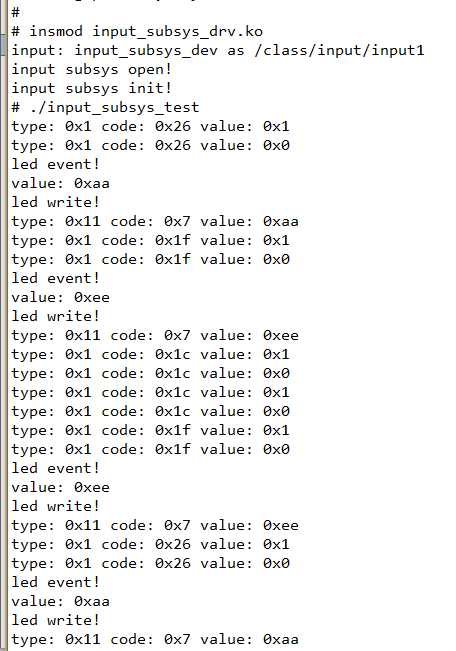
The end!
以上是关于UE4/5C++之SubSystem的了解与创建的主要内容,如果未能解决你的问题,请参考以下文章
linux输入子系统(input subsystem)之evdev.c事件处理过程
linux输入子系统(input subsystem)之按键输入和LED控制
WSL(Windows Subsystem for Linux)的安装与使用